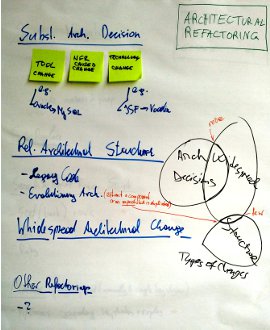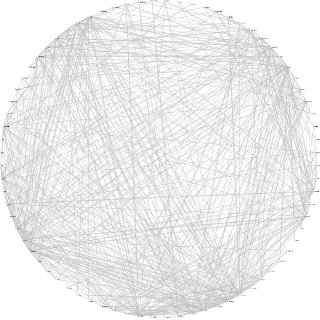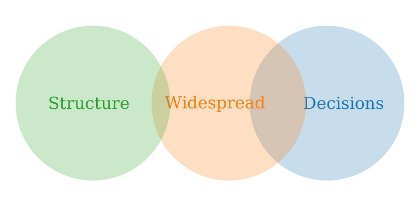1. Substitute Architectural Decision
In this category I collected Refactoring techniques which replace whole parts of an architecture, e.g.
- Replacing one relational database system with another
- Replacing the relational database with a NoSQL one
- Replacing UI technologies, e.g. moving from JSF to Vaadin
 1.1. Tool Change
1.1. Tool ChangeA Tool Change affects the implementation of a "tool", e.g. the database system. The first change in the previous list - replacing one relational database system with another - is a Tool Change. Upgrading libraries or migrating between similar frameworks is a Tool Change too. Initially I had listed them as Widespread Architectural Change. While upgrading or migrating libraries might require similar changes throughout the whole project, they are motivated by the Architectural Decision to use a certain version of a library.
1.2. Technology Change
A Technology Change modifies a used technology. Items two and three of the previous list are Technology Changes. In my experience, most Architectural Refactoring is of this type.
1.3. (Other) NFR Caused Change
Changing a tool or technology is never done for its own sake. We might upgrade a framework for the improved performance of its new version, or switch to another data store because it is more reliable or its license is more suited for the business. NFRs (Non Functional Requirements) are requirements that specify how a system is supposed to be in contrast to functional requirements which define what a system is supposed to do. NFRs usually contain long lists of attributes describing a system like performance, reliability and also security, traceability and globalisation. Examples of such changes are changing aspects like logging or security or applying internationalization. Again I had initially listed them as Widespread Architectural Change.
2. Refactor Architectural Structure
The second category deals with architectural building blocks like components, layers or packages. There are two causes for changing these:
 2.1. Cleaning up Legacy Code
2.1. Cleaning up Legacy CodeWhen we start a new project, its architecture is clear. When the system becomes more complex, effects known as Software Architecture Erosion or Architectural Drifts happen. These effects can lead to systems where the realisation of the system diverges from the intended architecture with resulting negative impacts on quality attributes associated with the intended architecture. Uncle Bob uses other words: The architecture starts to rot like a piece of bad meat.
For example look at the package tangle on the right: Several teams were working on a shared code base under an aggressive schedule and produced an architecture where each package was depending on all others, resulting in the legendary Big Ball of Mud architecture. To clean up this mess components with clear interfaces had to be introduced.
2.2. Evolving an Architecture
Today we rather embrace evolving requirements than stick to a big up-front plan. Techniques like Evolutionary Design accommodate the need of changing the design while systems are growing. And also their architectures need to evolve, e.g. we need to extract a new component or aspect which became duplicated during addition of structure to support new features. With the rising popularity of Microservices and their focus on incremental change in the architecture, Evolutionary Architecture has become a reality.
3. Widespread Architectural Change
I am mostly interested in these changes because I want to automate them. I described some basic tools and some more powerful ones. Most examples of changes I used were motivated in the change of Architectural Decisions. Even coding conventions can be seen as part of the NFR Maintainability. There is definitely an overlap, as some architectural Refactoring and also a few structural ones, will be widespread. Adi drew me a Venn diagram to explain that overlap:

4. Other Architectural Changes
I am still uncertain if there are other kinds of architectural changes. I miss examples. If you have some, please come forward!








No comments:
Post a Comment